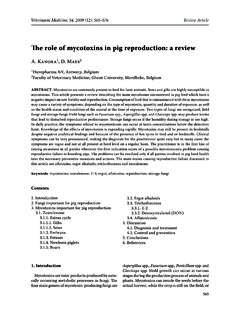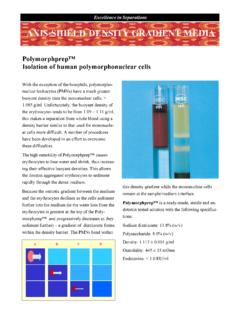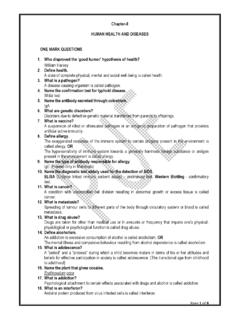Transcription of Innate and adaptive immunity in teleost fish: a review
1 review Article Veterinarni Medicina, 56, 2011 (10): 486 503486 Innate and adaptive immunity in teleost fish : a reviewC. Uribe1, H. Folch2, R. Enriquez1, G. Moran11 Faculty of Veterinary Science, Universidad Austral de Chile, Valdivia, Chile2 Faculty of Medicine, Universidad Austral de Chile, Valdivia, ChileABSTRACT: The immune system of fish is very similar to vertebrates, although there are some important dif-ferences. fish are free-living organisms from the embryonic stage of life in their aquatic environment. They have mechanisms to protect themselves from a wide variety of microorganisms. Consequently, fish rely on their Innate immune system for an extended period of time, beginning at the early stages of embryogenesis. The components of the Innate immune response are divided into physical, cellular and humoral factors and include humoral and cellular receptor molecules that are soluble in plasma and other body fluids.
2 The lymphoid organs found in fish include the thymus, spleen and kidney. Immunoglobulins are the principal components of the immune response against pathogenic organisms. Immunomodulatory products, including nucleotides, glucans and probiotics, are increasingly used in aquaculture production. The use of these products reduces the need for therapeutic treatments, enhances the effects of vaccines and, in turn, improves the indicators of production. The aim of this review is to provide a review of the immune system in fish , including the ontogeny, mechanisms of unspecific and acquired immunity and the action of some : fish ; immune response; immunomodulatorsCRP = C-reactive protein; ICM = intermediate cell mass; IHNV = infectious hematopoietic necrosis virus; IL = interleukin; INF = interferon; IPNV = infectious pancreatic necrosis virus; I S AV = infectious salmon anaemia virus; LPS = lipopolysaccharide; MHC = Major histocompatibility complex; MMCs = melanomacrophage centers; SAA = serum amyloid protein; TCR = T cell receptor; TLR = toll-like receptor; TNF = tumour necrosis factor; VHSV = viral haemorrhage septicaemia virusContents1.
3 Introduction2. Ontogeny of the immune system3. Lymphoid Spleen4. Cells involved in immune response5. Nonspecific Physical Nonspecific cellular Antimicrobial Tumor necrosis factor (TNF) Interferon (INF) Interleukins (IL) Others cytokines and Protease Natural Transferrin6. Specific Immunological Cellular Cytokines involved in adaptive immunity7. Environmental effect on immune response 8. Compounds that modulate the immune system in Probiotics9. Concluding remarks10. ReferencesVeterinarni Medicina, 56, 2011 (10): 486 503 review Article4871. Introduction The immune system of fish is physiologically similar to that of higher vertebrates, despite cer-tain differences. In contrast to higher vertebrates, fish are free-living organisms from early embry-onic stages of life and depend on their Innate im-mune system for survival (Rombout et al.)
4 , 2005). Nonspecific immunity is a fundamental defence mechanism in fish . In addition, it plays an key role in the acquired immune response and homeostasis through a system of receptor proteins. These recep-tor proteins identify molecular patterns that are typical of pathogenic microorganisms, including polysaccharides, lipopolysaccharide (LPS), pep-tidoglycan bacterial DNA, viral RNA and other molecules that are not normally on the surface of multicellular organisms. This response is divided into physical barriers and cellular and humoral im-mune response. These inmunological parameters include growth inhibitors, lytic enzymes, the classic complement pathways, the alternative and lectin pathway, agglutinins and precipitins (opsonins and primary lectins), antibodies, cytokines, chemok-ines and antibacterial peptides. Various internal and external factors can influence Innate immune response parameters.
5 Temperature changes, stress management and density may have suppressive ef-fects on this type of response, while several food additives and immunostimulants can enhance their efficiency (Magnadottir, 2006, 2010).The aim of this review is to provide some back-ground on the immune system of fish , describing the ontogeny and core components, the nonspecific and adaptive immune mechanisms and elements that promote their actions as Ontogeny of the immune systemThe ontogeny of the immune system of teleost fish has been studied in various species, includ-ing rainbow trout (Oncorhynchus mykiss), catfish (Ictalurus punctatus), zebrafish (Danio rerio) and grouper (Acanthistius brasilianus). Teleosts have been described as primitive models of hematopoi-esis. The first hematopoietic organ is called the in-termediate cell mass (ICM).
6 In kili (Pseudepiplatys annulatus) and rainbow trout, hematopoiesis exists for a short period in the yolk sac and then shifts to the ICM (Zapata et al., 2006). With respect to the development of the organs involved in the immune response, the anterior kidney and thymus are con-sidered to be complete before hatching occurs in rainbow trout and Atlantic salmon (Salmo salar) (Razquin et al., 1990); this has not been clarified at the end of incubation in many marine species, in-cluding bream (Sparus aurata), grouper and turbot (Scophthalmus maximus). Despite these differences, the sequence of lymphomyeloid organ development in marine teleosts is as follows: kidney, spleen and thymus (Mulero et al., 2007), but larval spleen has a greater erythropoietic function than lymphopoetic function (Nakanishi, 1986; Schroder et al., 1998).
7 Cells of myeloid lineage can be found around the yolk sac from 24 hours post fertilization (hpf ) but are not seen in the ICM. Myeloblasts and neutrophilic myelocytes are observed between 34 and 48 hpf. On the other hand, numerous erythrocytes circulate in the blood vessels, and mature granulocytes are found in the blood system in the connective tissue that surrounds the yolk sac at 34 hpf and adjacent to the first renal tubules at 48 hpf. In addition, young myelocytes and neutrophils migrate through blood vessel walls during the same period. Mature neu-trophils are described in various tissues at 72 hpf (Willett et al., 1999).On the other hand, the first appearance of IgM in lymphocytes varies considerably among fish species (Magnadottir et al., 2005). However, the first appear-ance of B-lymphocytes and immunoglobulins is late in marine species compared to fresh water species, and larvae have reached about 20 30 mm in length when IgM is first expressed (Chantanachookhin et al.)
8 , 1991; Magnadottir et al., 2005). In addition, Dalmo (2005) mentioned that the transfer of mater-nal antibody to eggs and embryos has been demon-strated in several species. Further, Magnadottir et al. (2005) suggest that the primary role of maternal anti-bodies is to protect the eggs against vertical transfer of certain pathogens or that maternal IgM may aid phagocytosis or the activation of complement path-ways in early developmental stages; IgM may even function simply as a nutritional yolk , complement component C3 has been found in unfertilised eggs in the spotted wolfish (Anarhichas minor Olafsen) indicating maternal transfer (Ellingsen et al., 2005). Using immunohisto-chemistry techniques, C3 has been found in several different organs and tissues of developing cod and halibut (Lange et al., 2004a,b).
9 These studies suggest that complement may play a role in the generation of different organs and not only in the defence against invading pathogens (Dalmo, 2005). review Article Veterinarni Medicina, 56, 2011 (10): 486 5034883. Lymphoid organsThe thymus, kidney (anterior and middle) and spleen are the largest lymphoid organs in teleosts (Zapata et al., 2006). In freshwater teleosts, the thymus is the first organ to become lymphoid, but before this event, the anterior kidney may contain hematopoietic progenitors, but not lymphocytes (Lam et al., 2004). ThymusThis organ has two lobes, is homogeneous, and is represented by a thin sheet of oval lymphoid tissue that is arranged subcutaneously in the dorsal com-missure of the operculum and is lined by mucous tissue of the pharyngeal epithelium (Ellis, 2001). The structure that characterizes the thymus of fish is a capsule that surrounds the lymphoid bark tissue.
10 Basically, the thymus can be considered as an aggregation of macrophages that promote the encapsulated proliferation of T cells (Davis et al., 2002). The differentiation of the thymic structure is highly variable in teleosts, and in many spe-cies, it is not possible to observe a clear differ-entiation between the cortex and medulla that is found in higher vertebrates (Bowden et al., 2005). Furthermore, myeloid cells and eosinophilic granu-lar cells can be found in this organ. Other studies described the appearance of focal epithelial nests, known as Hassal s corpuscles (Zapata et al., 2006). The thymus is responsible for the production of T cells. In zebrafish, thymus development involves neural crest cells derived from the neuroectoderm, which migrate to the third and fourth pharyngeal pouches and interact with the endoderm (Trede et al.)









